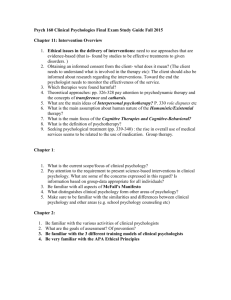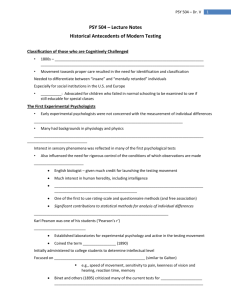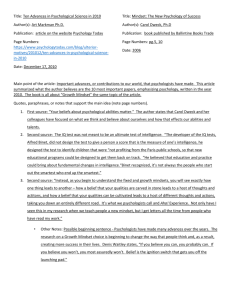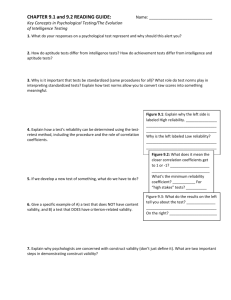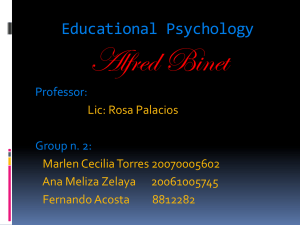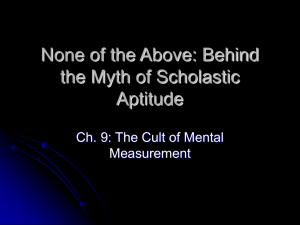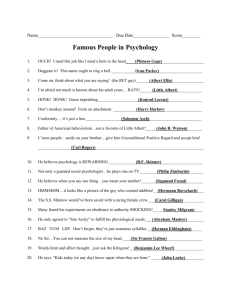Alfred Binet - Vidyaonline.org
advertisement
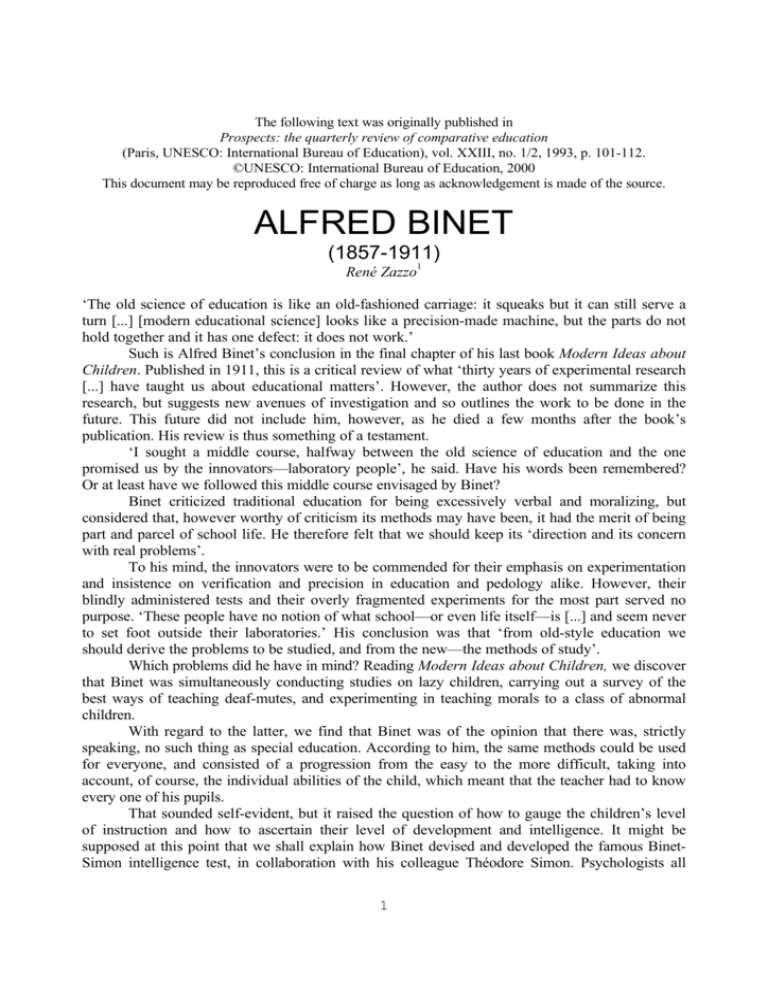
The following text was originally published in Prospects: the quarterly review of comparative education (Paris, UNESCO: International Bureau of Education), vol. XXIII, no. 1/2, 1993, p. 101-112. ©UNESCO: International Bureau of Education, 2000 This document may be reproduced free of charge as long as acknowledgement is made of the source. ALFRED BINET (1857-1911) 1 René Zazzo ‘The old science of education is like an old-fashioned carriage: it squeaks but it can still serve a turn [...] [modern educational science] looks like a precision-made machine, but the parts do not hold together and it has one defect: it does not work.’ Such is Alfred Binet’s conclusion in the final chapter of his last book Modern Ideas about Children. Published in 1911, this is a critical review of what ‘thirty years of experimental research [...] have taught us about educational matters’. However, the author does not summarize this research, but suggests new avenues of investigation and so outlines the work to be done in the future. This future did not include him, however, as he died a few months after the book’s publication. His review is thus something of a testament. ‘I sought a middle course, halfway between the old science of education and the one promised us by the innovators—laboratory people’, he said. Have his words been remembered? Or at least have we followed this middle course envisaged by Binet? Binet criticized traditional education for being excessively verbal and moralizing, but considered that, however worthy of criticism its methods may have been, it had the merit of being part and parcel of school life. He therefore felt that we should keep its ‘direction and its concern with real problems’. To his mind, the innovators were to be commended for their emphasis on experimentation and insistence on verification and precision in education and pedology alike. However, their blindly administered tests and their overly fragmented experiments for the most part served no purpose. ‘These people have no notion of what school—or even life itself—is [...] and seem never to set foot outside their laboratories.’ His conclusion was that ‘from old-style education we should derive the problems to be studied, and from the new—the methods of study’. Which problems did he have in mind? Reading Modern Ideas about Children, we discover that Binet was simultaneously conducting studies on lazy children, carrying out a survey of the best ways of teaching deaf-mutes, and experimenting in teaching morals to a class of abnormal children. With regard to the latter, we find that Binet was of the opinion that there was, strictly speaking, no such thing as special education. According to him, the same methods could be used for everyone, and consisted of a progression from the easy to the more difficult, taking into account, of course, the individual abilities of the child, which meant that the teacher had to know every one of his pupils. That sounded self-evident, but it raised the question of how to gauge the children’s level of instruction and how to ascertain their level of development and intelligence. It might be supposed at this point that we shall explain how Binet devised and developed the famous BinetSimon intelligence test, in collaboration with his colleague Théodore Simon. Psychologists all 1 across the world are familiar with this test, which has been translated and adapted into a dozen different languages. It has, in fact, become so well known that it has far outstripped the fame of its originator. Alfred Binet has been thrust into the shadows by the Binet-Simon scale. We should, on the contrary, like to show here how the development of this test casts light on the way Binet thought, and how it is the outcome of a whole series of activities. To begin with, however, it is necessary to say something about Binet himself, and in order to get to know him better and place him in the intellectual context of his time, it would be helpful to look at a few milestones in his life and career. One life—many different paths Alfred Binet was born in Nice in 1857. His father was a doctor and his mother a painter. After completing his secondary schooling in Paris at the Lycée Louis-le-Grand, he went on to study law. In the course of his law studies, he began to show an interest in a completely different area. In 1880, the distinguished Revue philosophique, edited by Théodule Ribot, published Binet’s first two articles on the psychology of sensations and images, subjects that were then being debated. Ribot encouraged Binet to continue working in the new direction he had begun to take. Throughout the 1880s Binet showed himself to be an extraordinarily intense worker with an astonishing capacity for aiming at several different objectives simultaneously. During this period, he became skilled both in psycho-physiology and in clinical psychiatry. Under the direction of the embryologist Balbiani—whose daughter he married in 1884—Binet began to study natural science at the Sorbonne and to conduct experiments. With Charcot at the Salpétrière hospital, whom he had met through a classmate from Louis-le-Grand, he discovered the field of hypnosis and suggestion, and began work on what he termed ‘morbid psychology’. The birth of his two daughters, Madeleine (1885) and Alice (1888), was nevertheless to provide him with another, entirely new, centre of interest—child psychology—and more specifically the study of individual differences in relation to education and genetic inheritance. This in no way interfered with his embarking on other fields of study. In 1890, on a railway platform, he made the chance acquaintance of Henri Beaunis, director of the laboratory of psycho-physiology founded the year before at the Sorbonne. He offered to work with Beaunis and Beaunis agreed. In 1892, he was contacted for the first time by Théodore Simon, recently assigned to a psychiatric internship at the Perray-Vaucluse centre, who sought Binet’s advice concerning the education of the abnormal children in his care. Although he needed some coaxing, Binet finally agreed to co-operate, and so the indissoluble and history-making partnership of Binet and Simon was born. The year 1894 was particularly outstanding in terms of Binet’s diverse interests, activities and accomplishments. He received his doctorate for a thesis devoted to the study of ‘the subintestinal nervous system of insects’; founded L’année psychologique with Beaunis whom he succeeded as director of the psycho-physiology laboratory; published Psychologie des grands calculateurs et joueurs d’échecs; and, in conjunction with Victor Henri and other researchers from the laboratory, published his Introduction à la psychologie expérimentale, as well as several articles on psychological problems and problems of educational psychology (suggestibility, memory, character, etc.). 2 However, educational concerns and the social objectives of education were to become Binet’s overriding interest, and he spent less and less time in the psycho-physiology laboratory. In 1898, he launched a series entitled Bibliothèque de pédagogie et de psychologie with Victor Henri. The following year, he joined the recently formed ‘Société libre pour l’étude psychologique de l’enfant’ founded by Ferdinand Buisson, Professor of Educational Science at the Sorbonne. Binet quickly became its mainstay. In 1904, Binet and Simon brought about the establishment of a ministerial commission to examine two problems: the diagnosis of different degrees of mental retardation and the education of abnormal children. Six months after this commission was established, Binet presented his diagnostic test, the first version of the Scale for the Measurement of Intelligence, to the International Congress on Psychology (Rome, 1905). In 1905, he obtained official recognition for a school-based research centre in the working-class neighbourhood of Belleville as an ‘experimental educational laboratory’, where he had already worked closely for many years with Vaney, the school’s principal. The following years were primarily devoted to developing his famous test. From 1909 to 1910, in response to a request from the War Ministry, he studied several dozen conscripts and took advantage of this opportunity to add an ‘adult’ level to his test. His health had begun to fail, however, and the day after a meeting of ‘La société libre’, he suffered a stroke, and died a few weeks later on 28 October 1911. He was 54 years old. Sixty years later, on 5 June 1971, I attended a ceremony at which a plaque was affixed to the building at 36, rue de la Grange-aux-Belles in Belleville. At the back of the hall where the ceremony was being held were twenty elderly people. I asked the school principal who they were, and I found his reply more moving than all the speeches we had just heard since he told me that they were some of the schoolchildren Binet had examined in the early years of the century at Belleville. The individual as a subject of study ‘Education should be preceded by a study of individual psychology’ (Modern Ideas about Children, 1911). ‘Individual differences are more pronounced for advanced thought processes than for elementary ones’ (La psychologie individuelle, 1896). Binet’s entire work as an educator is based on these two principles. The second theory is his own and we will see how he used it in developing his intelligence test. The first, which confers a scientific status on the individual, derives from Darwin’s ideas about evolution, then in the first flush of youth, as developed by Darwin’s cousin Francis Galton. The Origin of Species, published in 1859, stated for the first time that the evolution of species could be explained by natural selection, which implied the existence of individual distinctions that were hereditary to a greater or lesser extent. Galton was endeavouring to produce proof of this. In order to do so, and to evaluate the respective contributions of heredity and environment (nature and nurture), Galton decided to compare the physical and mental similarities and differences of sets of identical and fraternal twins (The History of Twins, 1875). He developed tests—of an early type—and defined experimental psychometrics as ‘the art of imposing measurement and number on the functioning of the mind’. In devising his method based on the study of twins, he also discovered the statistical concept of correlation. Galton was primarily concerned with heredity, however, and Binet did not find in his ideas anything affecting education. The theory of evolution, whose subversive message echoed the 3 industrial revolution and its repercussions, was nevertheless going to redefine the goals and approach of the human sciences, which Binet noted when he welcomed a renewal of interest in experimental psychology. He adopted the expression mental tests, coined in 1890 by McCattell, to designate individual testing instruments, and also adopted the term pedology, invented by a certain Chrisman in 1894, to describe the science of the child. Where new theories were concerned, he was primarily attracted to what had become known as ‘the American front’, which included John Dewey, ‘the teacher’s teacher and John the Baptist of democracy’, and James Mark Baldwin, mocked as the ‘nursery psychologist’ by traditionalists. Dewey and Baldwin were both on the side of evolutionism, but much more important to Binet was their keen sense of observation and their interest in the diversity of individuals. When an experimentalist criticized him for not providing a strict definition of the psychological phenomenon to be observed and for examining subjects unfamiliar with laboratory techniques and not trained in introspection, Baldwin replied that things were perfectly al right as they were. Psychological investigation should focus on the diversity of human minds, whether trained or not. Indeed, training tended to mask individual differences, which was exactly what happened with the well-trained subjects at the Leipzig laboratory. When the experimenter retorted that the same components and the same laws should be found in all human minds, Baldwin replied that he was ignoring the lessons of nature, which was tantamount to saying that he was repudiating science. These remarks, which date from 1895, are a good illustration of the opposition that Binet himself encountered among the laboratory community. He had to prove that individual differences were not incompatible with the laws of science, but in order to do so, he had to catalogue, much more meticulously than Baldwin had done, ‘the lessons of nature’. He sought out, described and checked such individual differences in ordinary as well as in exceptional subjects—subnormal and very gifted children or those possessing unusual skills, such as mathematical prodigies, chess players, eminent authors and actors. His penchant for ‘characters’, along with his knowledge of ‘morbid psychology’, was to prompt another activity so far unmentioned: that of dramatist. In fact, in collaboration with André de Lorde, he wrote nine plays, performed for the most part at the Grand-Guignol and Sarah Bernhardt theatres; but this is not the topic of our discussion here. On the other hand, the question he raised concerning abnormal children is of very great importance. He asked whether what distinguishes them from ‘normal’ children is a matter of degree or one of kind. He then asked how the concept of difference can, in general, be defined and how any difference can be measured? Binet’s answers to these questions will be discussed later, when we examine how he resolved the thorny problem of measurement in psychology. Before Binet considered this problem, and while concerned with the education of abnormal children, he began, between 1898 and 1901, to examine ‘ordinary’ individuals. He published his collected observations on these people in 1903 in a book entitled L’analyse expérimentale de l’intelligence. ‘The twenty people who agreed to take part in my research,’ he said, ‘included adults and children, men and women, from all walks of life’. It is clear that with such a limited and heterogeneous sampling, Binet’s aim at that time was not to develop a scale of averages. In any event, averages were not then of interest to him, and he in fact shied away from them. He railed against the American obsession with large numbers. According to Binet, twenty subjects were quite sufficient for an accurate study of the higher functioning of the mind and its individual differences, and for developing an experimental method of analysis. 4 Twenty subjects were sufficient, or even two, as long as they could be compared. In fact, virtually the whole of his book was devoted to his two daughters, who appear in it under different names (Madeleine becoming Marguerite, and the younger daughter, Alice, Armande). ‘By the time I had finished the main experiments’, he informs us, ‘the older girl was 14 and a half and the younger 13.’ For three years, several times a month, Binet conducted numerous tests on the two girls. There was a wide variety, including memory, imagination and attention tests, description of objects, etc. However, he explains, ‘the primary purpose of this book is to study, in the ideation process, what makes each of us unique’. In summing up his findings, Binet, in his ‘conclusions’, presents contrasting portraits of his daughters, each having its own logic, consistency and harmony. In Marguerite we find precision of thought, a long attention span, a practical mind, a poor imagination, a lively interest in the outside world, etc. Armande’s thought processes, on the other hand, were not as well-defined. Her attention was easily distracted, she had a rich imagination, a weak sense of observation, a detachment from the outside world, etc. Binet asks himself if these two sisters ‘do not, curiously, represent - inasmuch as two individual human beings can represent a general picture—two important tendencies in human intelligence?’ For the time being, however, Binet had not yet come up with a definition of intelligence. Binet’s book illustrates in a masterly way his own progressive approach towards establishing a psychological science of differences. Not a word is said in the entire 307-page book about education or teaching. In line with the first principle stated above, we must accept it as a preliminary work. A footnote in the book is worth noting and thinking about: ‘I would have been happy to continue my experiments with my two daughters had I not noticed that with age, there have been some changes in their characters. The psychological portraits I sketched of them are less applicable today than they were three years ago; and it seems probable to me that in ten years’ time or so, other even more important changes will have taken place’ (p. 298). With regard to change, it should be noted that he uses the word character, and not intelligence or ideation. This is of little importance in any case. The fundamental question is that of the qualitative changes in the personality in the process of ontogenesis. The question posed by Binet, incidentally, has remained unanswered to this day. Psychological measurements We should not forget that, on the topic of individual differences, L’analyse expérimentale de l’intelligence (1903) preceded the development of the scale of measurement and, similarly, where educational psychology is concerned, that the publication of Enfants anormaux (1907) preceded Modern Ideas about Children (1911). Thus Binet advances from a purely qualitative description to an undertaking involving measurements, and from the education of mentally deficient children to that of all children. These two movements, both resulting in the unanticipated measurement of intelligence, represent not so much a complete break in Binet’s work as a change of direction. With regard to the creation of his intelligence test, he said towards the end of his life that ‘there is nothing like necessity for prompting new methods’. The necessity in his case was his desire to ‘do something for children’, and first of all for those unable to learn in the school environment. 5 Why were they unable? How could the seriousness of their disability be assessed? Could it, in some cases, be corrected? Education, and above all that of schoolchildren who had only recently been labelled as mentally defective, ‘is one of the most important questions of our time’. Mental deficiency is the product of compulsory education, which itself arose out of the ‘demands of a democratic and industrial society’. When illiteracy was common, only the most feebleminded, such as patients in asylums for the insane and village idiots, stood out. Educational research—with the exception of special education for the blind and deafmute—was thus first applied, in France and elsewhere, to the mentally deficient. Binet followed his principle that a meticulous psychological analysis and thorough diagnosis must precede any trial of the teaching methods that might be suitable for them. He thus refined his educational concepts, going from a definition of areas of unintelligence to a scale for the measurement of intelligence. In 1892, when Binet, along with Simon, began to take an interest in the education of abnormal children, compulsory primary education had existed in France for ten years (since the Law of 28 March 1882). This led him to question the shortcomings of such education. His first concern was to develop methods by which to diagnose the intellectual level not only of maladjusted children in primary schools, but also of ‘subnormal children in institutions’, of whom there were many in Perray-Vaucluse. The road to the construction of his measurement scale was a relatively long one, and very different from that of the psycho-physicists, who were the first to introduce measurement into psychology. The ideal of being scientific, which consisted of ‘applying measurement and number to the operations of the mind’, was apparently met in 1860 with the Weber-Fechner law according to which ‘the intensity of sensation is proportional to the logarithm of stimulus’. The problem is that psychology remains dependent on physics, since sensation could not be measured directly but only evaluated through the intensity of the stimulus. With the manifesto written in the form of an article by McCattell in 1890 and with the promotion of mental tests designed to evaluate individual differences for practical, educational and other purposes, a new direction was becoming apparent, diametrically opposed to that of laboratory psycho-physicists and psychologists. In America, the science of testing was in its heyday, yet no American psychologist had developed a test capable of measuring individual differences clearly and effectively when the first version of Binet’s measurement scale appeared in 1905. How was it that Binet had succeeded where McCattell’s compatriots had failed? The main reason is clear. While they rejected laboratory objectives, American psychologists nevertheless retained laboratory instruments; but it is difficult to distinguish clearly between individuals through their responses to sensory stimuli or by their reaction times. With Binet came the epistemological break. He was the first to apply the notion of measurement to higher mental processes and complex psychological phenomena, which until that time had been a field reserved for clinical intuition and literature. Nevertheless, how was it possible to arrive at a scale for measuring individual psychology? Binet had many apparently very different tasks in hand, but these soon began to converge. There was his own systematic observation of his daughters; he worked with Simon where mental patients were concerned; and he worked with Vaney and teachers on the educational evaluation of over 1,000 schoolchildren in Paris and the Paris region. Whoever the subjects were to be examined, they were always given a broad range of tests. Each individual, Binet said, is ‘a 6 network of tendencies, and [...] what we must be able to assess is the outcome of these tendencies’. The convergence between the strictly individual approach and measurement on a scale is manifest in Binet’s use of the data provided by Armande and Marguerite since most of the tests they were given appeared a few years later in the scale. Let us take as an example the test using an illustration of a boy and an old man pulling a cart. The child is asked what he or she sees in the picture. On the basis of his daughters’ replies, Binet distinguished several categories, e.g. descriptive, observational, emotional and so on. These categories were retained, for children under 10, for more detailed analysis of the results of the intelligence test. This constituted the clinical aspect of the test, giving it its individual character. However, the genetic angle gave a different picture. Replies are classified under three age-groups: enumeration at age 3, description beginning at age 7, and interpretation towards age 12. At age 3, the child enumerates people and objects without establishing any relationship between them. For example, he will say he sees ‘a man, a cart and a child’. No action is mentioned. At 7, the child sees ‘a man and a little boy pulling a cart’. Beginning at age 10 to 12, he will see ‘a homeless family leaving their village’, ‘people moving house’, etc. Obviously, the enumeration, description and interpretation vary in their formulation and emotional tone from one child to another. This must be taken into account in comments on the results. However, these age levels did not appear in the first version of the scale published with Simon in 1905. ‘Our goal’, said the authors, ‘is to determine if the child brought before us is normal or mentally deficient.’ The test consisted of thirty tasks in a series of increasing difficulty. The results were based on the calculation of the score, independent of age-group. The borderline between mental deficiency and normality was at task 25, where the subject was asked to make up a sentence using three words (Paris, fortune, stream), a test that was later revealed to correspond to the 10-yearold age-group. This test for identifying retardation was thus applicable only to children who had reached the end of childhood. Three years later, in 1908, the measurement scale proper was published, with its gradations from ages 3 to 13. The test for retardation had thus given way to the intelligence test, specifying at the same time the mental age. The term ‘scale of measurement’ itself predated the creation of the intelligence test in the work of Binet. Calculating years of advancement and years of backwardness was suggested to him by the practice of stages in education. He used it in collaboration with Vaney for working out instructional scales and also to evaluate the physical development (height, weight, chest measurement, etc.) of schoolchildren. In order to compare physical stature and school level, he had the idea of ‘replacing discrepancies (in relation to the average) of height in centimetres by differences in age’. Thus, for example, a child could be two years behind in physical size and one year behind in school. It was a practical step, but what were its theoretical implications? When we are dealing with different ages, noted Binet, one quantity is not contained in another. Twice 2 does not equal 4. As early as 1898, in his article entitled ‘La mesure en psychologie individuelle’, he had written: ‘I think that psychological and educational measurement is not true measurement but simply a form of ranking’. In Modern Ideas about Children, speaking specifically about his measurement scale, he adopted a different approach: ‘Here the word measurement is not used in the mathematical sense [...] It covers a whole system of evaluation that we believe to be new and whose main implications we do not have the time to explain [...]’. 7 The question nevertheless remained as to whether, with this non-mathematical measurement, a given figure or level had the same value regardless of the age of the child. For example, would a mental age of 5 for a 10-year-old child be equivalent to the level of a child of 5? The question was even more important for an educator than for a psychologist. Binet gave his reply in 1908 in a commentary on his observations: ‘So far, what strikes us are the similarities between normal and abnormal children. They are so numerous that when you read the reaction reports of a child of unspecified age, you cannot say whether the child is normal or abnormal’. However, he found it odious to equate the intelligence of a backward child with that of a normal one. ‘Certain differences might be concealed beneath the similarities and one day perhaps we shall succeed in identifying them.’ But depending on whether a backward child can or cannot be treated as a normal child, his education and the kind of teaching he needs will be identical or different. To begin with, can the diagnosis enable any prognosis to be made? Is it possible to foresee the future? The answer is that no predictions can be made; the present situation can be noted and that is all. In setting up remedial classes, the first of which was opened by Binet himself in 1907, he sought to test the educability of retarded children whose mental level he had previously measured. Nevertheless, what is the real purpose of this measurement that is not a ‘true measurement’? In other words, what is intelligence? Binet did not define it, even when he subjected it to his ‘experimental analysis’. He retained the imprecision of ordinary language, doubtless so as not to run the risk of arbitrary theorizing. What eventually led him to a definition were ten or so years of observation and experiment. In the 1905 article in which he outlined for the first time the principles underlying his test, he said that ‘the fundamental organ of intelligence is judgement, that is to say common sense, a practical outlook, initiative and the ability to adapt’. In Modern Ideas about Children the terminology is different: ‘Understanding, inventiveness, direction and censure: intelligence is summed up in these four words’. By censure he meant that, in any intellectual activity, ‘ideas are weighed up as and when they occur and are rejected if unsuited to the objective being pursued’. The educator: assessment and prospects The striking thing about Binet is the singular way in which his ideas developed, coupled with the unorthodox views he adopted in all fields: in psychology, which was trying to find its niche between philosophy and physiology; in psychometrics, which was more or less in thrall to the tradition of the natural philosophers; and in the then ebullient world of educational psychology. This singularity has often been unwelcome or misunderstood. Even today, a striking example is provided by the education of retarded children, with many voices favouring the integration of these children into ordinary schools. Binet, as the promoter of special education and the creator of remedial classes, is furiously attacked as responsible for psychological discrimination based on an ideology of segregation and exclusion. As has been emphasized by Guy Avanzini, the shrewdest expert on Binet’s research, his intentions were exactly the opposite. He believed in the perfectibility of abnormal children - but insisted that such perfectibility must be verified. Remedial classes were devised as means of preparing the way, as far as possible, for children to move into ordinary classes. Binet himself took on the task of finding, by means of his test, about fifty retarded children, organizing how they should be taught and educated, and looking to see what hitherto unrecognized aptitudes they might have. 8 He found that many of them had skills and motor dexterity roughly equal to those of children of the same age. From this point of view, they were not retarded. For them, the workshop was to become a more important place of instruction than the classroom, which amounted to an early application of the active method. For the others, there was hope of a return to normal schooling, even if they were a year or two behind. Binet had opened up new possibilities—two potential solutions that needed to be confirmed. Here we find a constant feature of Binet’s thinking which corresponds quite closely to the combined effect of censure and inventiveness. It is illustrated in the opening lines of this article by what he thought about the respective qualities of the old and the new science of education. It is also reflected in his anxiety to avoid the trap of a facile word, idea or practice. This applied as much to his own contributions as to those of other people. To illustrate this, let us take his two major themes—the establishment of individual psychology and the need for an objective measurement of intelligence. ‘My test’, he said, ‘is not like a weighing machine in a station which prints out your weight on a ticket.’ Its results need to be examined, set within a context and interpreted. His measurement scale ‘is an instrument that must not be allowed to fall into the hands of a fool’. Where individual psychology was concerned, Binet was troubled by the zealousness of certain educators whose ideal was a tailor-made school in which teaching would be totally individualized. If we ask too much, he said, we will achieve nothing; if we take a legitimate idea too far, we distort it. ‘Public education’, he went on, ‘cannot be other than collective education, given by a teacher to a number of pupils together [...] Collective education must not be rejected outright because it has advantages that we cannot do without: without it there would be no imitation or emulation, [which are] such powerful stimulants for progress.’ In other words, solutions have to be devised that preserve the advantages of group instruction while taking account of individual differences. ‘For this, we must not rely too much on new regulations from the Ministry. It would be infinitely more useful for teachers to take an interest in their pupils’, to take the trouble to get to know them individually. ‘All that we can ask of an understanding government is to reduce the number of overcrowded classes.’ Binet says that the public blames the authorities, i.e. the government, for what is known by the odd and highly debatable expression of the crisis in education (his own emphasis). ‘Immediately, everyone comes up with the same idea: there is only one remedy and that is to change the curricula.’ This view had to be criticized for being exclusive. Just as important, if not more so, were the need to adapt the school to the aptitudes of the children and the methods of teaching. Binet employed ‘method’ in a very broad sense as covering the way primary teachers were recruited, their training, regulations on the length of lessons, the timetable (which determined, for example, what subjects should be taught first thing in the morning), and the timing and length of school holidays. All these questions, to which Binet tried to find answers, were dominated in his thinking by the need to take account of the children’s mental fatigue and workload. On the subject of moral education, Binet revealed the roots of his philosophy. Now that schools were secular, how were children to be taught morality? Against religious education that was accused of enslaving the soul, was being set an education of complete freedom; but that was going from one extreme to another. ‘People now talk ceaselessly’, observed Binet, ‘of the rights of the child and of the rights of its conscience’, but that was to confuse the methods of education with its purposes. ‘The purpose is to form free men and women, but the method cannot consist in treating the child as a free adult, nor in appealing to its reason when the child has not yet attained the age of reason’. 9 Moral training stemmed from two principal motivations. First was ‘the child’s respect for its parents and its teachers’. This contains the idea of authority, duty and obligation without which no moral sense can be effective. Next came the feelings of altruism, goodness and disinterestedness, ‘all those warm and tender impulses which lead to self-sacrifice and give morality a heart’. With this lesson for teachers, Modern Ideas about Children closes. No longer lost in the shadow of the Binet-Simon test, Binet now appears to us in a clear light. Most of the questions he raised, the answers he gave to some of them and the prospects he opened up are still relevant today. Note 1. René Zazzo (France). Director of the Laboratory of Child Psychology at the Ecole Pratique des Hautes Etudes, Paris, and professor at the University of Paris X, now retired. He was president of the Société Francaise de Psychologie and of the Association de Psychologie Scientifique de Langue Francaise and co-founder of the Société pour l’Etude de la Débilité Mentale. He is the author of some fifteen books, including Le devenir de l’intelligence [The Future of Intelligence]; Conduites et conscience [Conduct and Conscience]; L’attachement [Affection]; Le paradox des jumeaux [The Paradox of Twins], and Reflets de miroir et autres doubles [Reflections and Other Replicas]. Bibliography Abbreviations: L’année psychologique: A.P.; Bulletin de la Société libre pour l’étude psychologique de l’enfant: Bul.; Revue philosophique: R. Phil. Selected publications by Binet Binet, A. 1880 Du raisonnement dans les perceptions. R. Phil. ——. 1886. La psychologie du raisonnement. Paris, Alcan. (Published in English as: The Psychology of Reasoning. Chicago, IL, Open Court, 1896.) ——. 1890. Recherches sur le mouvement de quelques jeunes enfants. R. Phil. ——. 1894. Enquête sur le caractère des enfants. R. Phil. ——. 1894. Introduction à la psychologie expérimentale. Paris, Alcan. ——. 1895. La peur chez l’enfant. A.P. ——. 1898. La mesure en psychologie individuelle. R. Phil. ——. 1898. La fatigue intellectuelle. Paris, Schleicher. ——. 1901. Quelques réflexions sur l’application de la méthode expérimentale à la pédagogie. Bul., No. 2. ——. 1903. L’étude expérimentale de l’intelligence. Paris, Schleicher. ——. 1904. La commission ministérielle pour les anormaux. Bul., No. 18. ——. 1904. La ressemblance de deux jumelles. Bul., No. 18. ——. 1905. A propos de la mesure de l’intelligence. A.P. ——. 1907. Les nouvelles classes de perfectionnement. Bul., No. 41. ——. 1911. Les idées modernes sur les enfants. Paris, Flammarion. Republished by Flammarion in 1973 with a Preface by Jean Piaget. (Published in English as: Modern Ideas about Children. Menlo Park, CA, Suzanne Heisler, 1984. 235 p.) ——; Vashide, N. 1897. La psychologie à l’école primaire. A.P. ——; Simon, T. 1905. Application de méthodes nouvelles au diagnostic du niveau intellectuel chez les enfants anormaux d’hospice et d’école primaire. A.P. ——; Simon, T.; Vaney, V. 1906. Recherches de pédagogie scientifique. A.P. ——; Simon, T.; Vaney, V. 1906. Le laboratoire de la rue Grange-aux-Belles. Bul., No. 34. ——; Simon, T. 1907. Les enfants anormaux. Paris, A. Colin. ——; Simon, T. 1908. Le développement de l’intelligence chez l’enfant. A.P. (Published in English as: The Development of Intelligence in Children. Baltimore, 1916.) 10 ——; Vaney, V. 1910. La mesure du degré d’instruction d’après des recherches nouvelles. Bul., No. 66. ——; Simon, T. 1911. La mesure du développement de l’intelligence chez les enfants. Bul., double issue, Nos. 7071. Selected publications about Binet Avanzini, G. Alfred Binet et la pédagogie scientifique. Paris, Vrin, 1969. Bertrand, F.-L. Alfred Binet et son oeuvre. Paris, Alcan, 1930. Mialaret, G. Alfred Binet et la pédagogie expérimentale. Bul., No. 500, 1958. Zazzo, R.; Gilly, M.; Verba-Rad, M. Nouvelle échelle métrique de l’intelligence: Analyse et révision du test ‘BinetSimon’. Paris, A. Colin, 1966. Hommage à Binet (pour le centenaire de sa naissance). Psychologie française (Montrouge, France), No. 2, 1958. (Special issue with contributions by educationists, psychologists and psychiatrists and including ‘Quelques souvenirs personnels’ [Some personal memories] by Henri Piéron.) 11
